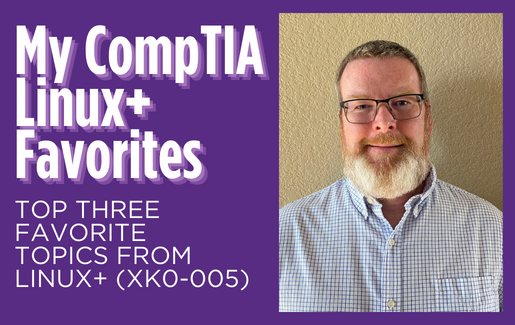 CompTIA Linux+ (XK0-005) is a great body of knowledge that can be summarized in one word: practical. From user management to security to service configuration, the new objectives provide learners with a great opportunity to master Linux. CompTIA has raised the bar with the new Linux+ by making the content more than just a Linux-for-beginners list of commands.
CompTIA Linux+ (XK0-005) is a great body of knowledge that can be summarized in one word: practical. From user management to security to service configuration, the new objectives provide learners with a great opportunity to master Linux. CompTIA has raised the bar with the new Linux+ by making the content more than just a Linux-for-beginners list of commands.
Follow along in this multi-part series as I break down my favorite topics and delve more deeply into the value this knowledge provides:
- My CompTIA Linux+ Favorites: Git
- My CompTIA Linux+ Favorites: Vim
- My CompTIA Linux+ Favorites: Containers
1. Git to Work
Git seems to have taken over the world these days. For those unfamiliar, Git is a version control mechanism for developers. It allows users to clone centrally stored code, make modifications and commit those modifications back to a repository. However, Git has grown well beyond the realm of developers, and the Linux+ content recognizes the importance of this tool by providing a simple yet effective list of Git skills any IT person should know.
Git is the subject of the first article in the series.
2. The Importance of Vim
After all these years, I’m just going to admit it: I like Vim. It is intuitive, simple and precise. I don’t care for the big word processors that try to think for me and place invisible formatting instructions around my text. I like plain and simple editors, so, naturally, this program is one of my favorite sections of Linux+.
Historically, Vim was ubiquitous on Linux distributions. Now, you may be as likely to find Nano installed as Vim, but I’ll always add Vim back in. Linux configurations are stored in text files, so to change configurations one must be able to edit text files — exactly the functionality Vim provides. The Linux+ objectives cover enough about Vim to manage basic editing and several tricks to make the process far more efficient.
My second article covers some of the most practical aspects of Vim.
3. I Can’t Contain(er) My Excitement
Containers are one of the more recent buzzwords in the IT world for a reason. Virtualization via containers often simplifies deployments, permits flexible configuration and makes great use of available resources. Linux is the definitive platform for containers, so it seems natural that this new topic is one of my favorites. Pulling, running, and managing containers is clearly and concisely covered, emphasizing the importance of the technology.
The third article in the series looks more closely at the practical way CompTIA Linux+ covers containers.
Only Three?
It was difficult to narrow the scope down to three “favorite” Linux+ topics. Many great areas exist and so many useful tools are covered, how could I choose only the three listed above? I’m going to sneak in a brief list of the subjects I considered covering in this series to satisfy your Linux+ appetite:
- User/group management, permissions, and access control
- Package management and software configuration
- Storage management, especially Logical Volume Manager (LVM)
- Service management and configuration files
- Remote administration techniques
- Network monitoring tools and practices
Linux in the Limelight
Not all of the CompTIA Linux+ (XK0-005) content is new. Many objectives focus on the key elements sysadmins need to know. Networking, configuration, installation, performance —these are all essential topics. The three mentioned above, however, stand out in my mind as interesting, relevant and perhaps a little fun. It’s these kinds of topics that let Linux+ (XK0-005) rise beyond more entry-level Linux courses into something anyone can benefit from.
See all the topics covered by CompTIA Linux+ (XK0-005) by downloading the exam objectives for free.
Read more about Damon M. Garn’s favorites in Cloud+ and Server+.

